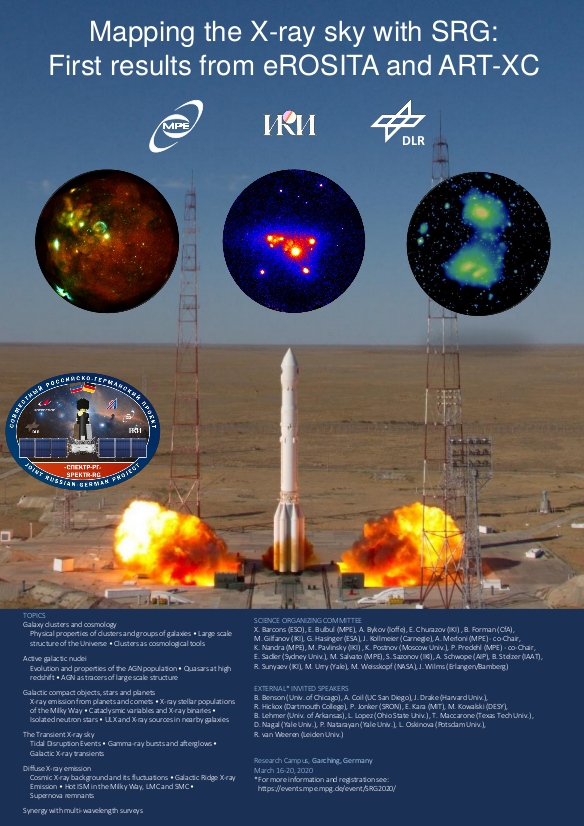Mapping the X-ray Sky with SRG: First Results from eROSITA and ART-XC
Garching



Please accept our sincere apologies for any disruption caused.
Further details about the rescheduling of the conference will follow in due course.
Scientific Rationale:
In little more than half a century, X-ray astronomy has established itself as a fundamental domain of observational astrophysics. X-rays probe the hot and energetic components of the Universe, encompassing, among others, the million degree coronae of stars, the remnants of supernovae, the ultra-dense matter in neutron stars, the immediate surroundings of black holes, the plasma filling galaxy clusters – the most massive objects in the Universe.
Successfully launched in July 2019, after more than a decade of development, the Russian-German Spectrum-RG (SRG) mission will contribute to the X-ray exploration of the Universe by performing eight all-sky surveys, each lasting half a year, with its two scientific instruments: eROSITA, the German-built telescope array operating between ~0.3-8 keV, and ART-XC, the Russian-built hard-X-ray focusing telescope array, operating between ~3-30 keV.
As in any other astrophysics domain, the SRG all-sky surveys will unlock large swathes of discovery space, provide large statistical samples to trace the cosmic evolution of various classes of objects, and explore sufficiently large volumes to serve as cosmological tools for the study the Universe as a whole. In particular, the high sensitivity, large field of view, and high survey efficiency of eROSITA is bound to revolutionize X-ray astronomy: within just the first year of operation it will discover about as many new celestial X-ray objects as have been discovered from 1962 until today.
The goal of the next international SRG conference (the third in a series, and the first after the SRG launch) is to discuss the state of the art in the different scientific areas addressed by the mission, present to the community the first results from eROSITA and ART-XC, and explore the synergies with surveys and observations at other wavelengths.
We plan to cover the following topics:
- Galaxy clusters and cosmology
- Physical properties of clusters and groups of galaxies
- Large scale structure of the Universe
- Clusters as cosmological tools
- Active galactic nuclei
- Evolution and properties of the AGN population
- Quasars at high redshift
- AGN as tracers of large scale structure
- Galactic compact objects, stars and planets
- X-ray emission from planets and comets
- X-ray stellar populations of the Milky Way
- Cataclysmic variables and X-ray binaries
- Isolated neutron stars
- ULX and X-ray sources in nearby galaxies
- The Transient X-ray sky
- Tidal Disruption Events
- Gamma-ray bursts and afterglows
- Galactic X-ray transients
- Diffuse X-ray emission
- Cosmic X-ray background and its fluctuations
- Galactic Ridge X-ray Emission
- Hot ISM in the Milky Way, LMC and SMC
- Supernova remnants
- Synergy with multi-wavelength surveys
Adam Malyali
Adriana Mancini Pires
Agata Różańska
Aishwarya Paliwal
Akos Bogdan
Alejandra Fresco
Alex Markowitz
Alexander Lutovinov
Alexander Meshcheryakov
Alexey Tkachenko
Alison Coil
Anatoly Iyudin
Andrea Botteon
Andrea Comastri
Andrea Merloni
Andreas von Kienlin
Andrew Strong
Andrey Semena
Andrey Shtykovsky
Angie Veronica
Ann Hornschemeier
Anna Ho
Antara Basu-Zych
Armin Vahdat Motlagh
Arne Rau
Avishay Gal-Yam
Axel Schwope
Aysegul Tumer
Barbara De Marco
Beate Stelzer
Beibhinn Whelan
Ben Maughan
Bradford Benson
Bret Lehmer
Cai Wood
Chandreyee Maitra
Chien-Ting Chen
Chris Tenzer
Christian Schneider
Christine Jones
Daisuke Nagai
Dan McCammon
David Alexander
David Bogensberger
David Russell
Didier Kileba
Diogo Coutinho
Dominik Bomans
Doug Swartz
Duy Hoang
Ece KILERCI-ESER
Edward Upsdell
Efrain Gatuzz
Ekaterina Filippova
Enza Magaudda
Eran Ofek
Ergun Ege
Erik Kuulkers
Erin Kara
Erwin Lau
Esra Bulbul
Eugene Churazov
Felix Aharonian
Florian Pacaud
Francois Mernier
Frank Haberl
Gabriele Ponti
Gebreziher Gidey
Georg Lamer
George Lansbury
Georgii Khorunzhev
Gerd Puehlhofer
Guinevere Kauffmann
Hartmut Scheuerle
Hermann Brunner
Hiroshi Nakajima
HITOSHI NEGORO
Holger Stiele
I-Non Chiu
Ido Reiss
Ildar Khabibullin
Ilfan Bikmaev
Ilkham Galiullin
Ilya Lomakin
Ilya Mereminskiy
Ingo Kreykenbohm
Iris Traulsen
Jacob Ider Chitham
Jan Robrade
Jann Aschersleben
Javier Garcia
Jeremy Drake
Jeremy Sanders
Jian Li
Jiri Svoboda
Joern Wilms
johan comparat
Johannes Buchner
John Silverman
John ZuHone
Jonathan Knies
Juergen Kerp
Julien Wolf
Jürgen Schmitt
Kirpal Nandra
Kohei Kobayashi
Konrad Dennerl
Konstantin Postnov
Konstantina Anastasopoulou
Konstantinos Migkas
Labani Mallick
Laura Lopez
Lidia Oskinova
Long JI
Luca Di Mascolo
Luigi Costamante
Manami Sasaki
Mara Salvato
Marat Gilfanov
Marcella Brusa
Marco Ajello
Marcus Brüggen
Marek Kowalski
Martin Mayer
Masamune Oguri
Matteo Guainazzi
Matthew Graham
Matthias Klein
Maurizio Paolillo
Meicun Hou
Melanie Lang
Melih Kara
Michael Freyberg
Michael McDonald
Miriam Elizabeth Ramos Ceja
Mirko Krumpe
Murray Brightman
Naomi Ota
Natalia Lyskova
Neven Vulic
Nhan Nguyen
Nhut Truong
Nicholas White
Nicolas Clerc
Nobuhiro Okabe
Norbert Schartel
Noriko Yamasaki
Norman Khan
Ole König
Paul Giles
Paul Plucinsky
Paul Woods
Pavel Medvedev
Peter Boorman
Peter Friedrich
Peter Jonker
Peter Predehl
Philipp Podsiadlowski
Philipp Weber
Priyamvada Natarajan
Qingcui Bu
Ralph Kraft
Rana Misato
Reinout van Weeren
Riccardo Arcodia
Riccardo Seppi
Rodion Burenin
Roman Krivonos
rosine lallement
Ryan Hickox
SAIKRUBA KRISHNAN
Sandro Mereghetti
Santina Piraino
Sara Buson
Sara Saeedi
Satoshi Miyazaki
Satoshi Nakahira
Sergey Molkov
Sergey Sazonov
Shri Kulkarni
Sinan ALLAK
Sotiria Fotopoulou
Stefan Czesla
Stefania Carpano
Stefano Bianchi
Stefano Marchesi
Steven Ehlert
Susanne Friedrich
Takamitsu Miyaji
Tanya Urrutia
Tathagata Saha
Teng Liu
Thomas Boller
Thomas Dauser
Thomas Kupfer
Thomas Maccarone
Thomas Mernik
Thomas Prince
Thomas Reiprich
Tingting Liu
Tom Shanks
Tony Mroczkowski
Tunca Amanvermez
Vadim Burwitz
Veronica Biffi
Victor Doroshenko
Victoria Grinberg
Vincent Eberle
Vittorio Ghirardini
Werner Becker
Werner Collmar
William Forman
Xueying Zheng
Yijun Wang
Yoshiki Toba
Zhen-Xuan Liao
Zhenlin Zhu

